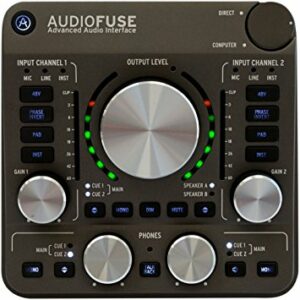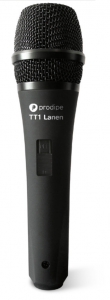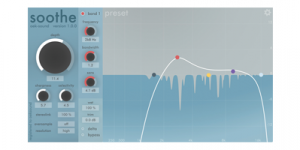Arturia AudioFuse
USB Audio Interface

Most bedroom producers start with an interface like the Scarlett 2i2. It is an excellent starting point, letting you monitor and record basic guitars, vocals easily. But as one goes down further into more serious production, you quickly realize the limitations of a beginner interface i.e. Low gain, higher noise floors, and limited connectivity.
Big things come in small packages
This interface was announced first in early 2015 but ended up making it to the market only recently. It fits in your backpack and even has a neat lid that goes on top which functions as a base when in use. The build quality is fantastic with a strong Aluminium chassis and real leather wraps on the lid. It comes in three different colors Deep Black (black lid, orange surround with lime green trim), Space Grey (white leather and dark grey aluminium) or Classic Silver (a lighter grey aluminium with brown leather surround.
Connectivity : Across the front , you’ll find combi inputs and two fully independent headphone feeds which can accommodate both mini-jack and 1/4″ plugs. At the back, there are speaker outputs for two pairs of monitors, line level connectors, MIDI In/Out ports and both S/P-DIF and ADAT In/Out allowing you to connect external preamps. There are also inserts for inputs 1 and 2, allowing you to track through hardware compressors or channel strips which can also be used for reamping guitars. The AudioFuse can be bus powered and includes a custom USB cable that lets it draw power from 2 USB hubs. But for full range functionality, there is an included power supply adapter. It also includes a built-in USB hub with 3 extra ports. This can be great for connecting things like license dongles, hard disks, and Midi controllers.
The interface features plenty of buttons that offer extremely tactile control for functions like switching monitors, dim, mute, switching between different cue mixes and preamp controls. In addition to this, there is an Arturia Control Centre software that offers an option to change settings on the screen.
How it sounds
Arturia has placed a lot of emphasis on their ‘DiscretePRO’ mic preamps. Each has its own analog gain control, along with switchable phantom power, polarity inversion, and pad. The preamps are great for an interface not just for this price range but overall. You get a lot of clean gain with minimal noise. In fact, every Audiofuse comes with an ‘Achievement Certificate’ containing Audio Precision measurements of each preamp’s equivalent input noise, frequency response and gain range that is specific and unique to each interface. It adds a nice touch to the unboxing experience and gives everything a premium feel. The pre-amp gain ranges from 2db to 75 db and Arturia claims that these are some of the quietest Preamps available. The frequency response is flat to ±0.06dB within 20Hz-20kHz.
Conclusion
Certain downsides that one might point out is that the sheer number of buttons and controls may make it seem a bit too cluttered to some. The interface also tends to heat up quite a bit over extended periods of use. It has proved itself to be stable and reliable under normal to moderately heavy use. All things considered, it makes it a great interface. It can be great for producing and recording with a laptop on the fly. It comes in at Rs.48,500 which still puts it a tad below the range of the UAD Apollo and is worth the money for someone looking to upgrade their beginner setup to something a bit more substantial.
Prodipe TT1
Dynamic Microphone an alternate for the sm58, at half the price?

The Prodipe TT1 aims to be a worthy rival and costs less than half the price of an SM58. Don’t let the cost fool you though. It packs a serious punch for the price. They claim to keep costs down with a combination of French engineering and Asian manufacturing, which they are unapologetic and even proud of. This mic has a solid build quality, with a Black rubber coating and a sturdy foam lined basket that unscrews for easy cleaning. At initial impression, they prove to be quite a durable product. There is an on/off switch and a screw to lock it in the on position if necessary. The mic comes with a stand clip and a soft carrying case.
TECHNICAL SPECS
Much like the SM58, it has a cardioid pattern and boasts a high output level. Its specified frequency response is 50Hz-15Khz with a broad and generous bump starting at 2kHz going all the way up to 8Khz. It should understandably perform quite well for live duties but is also built for studio use. In a studio shootout with an SM58 and an Audio Technica ATR 1300, it performed remarkably well, with most of the target listening group choosing the Prodipe over the other two. The test was performed with a vocalist and was noticeably fuller in the low end than the SM58. The upper midrange bump also gives it a very forward sound without being too harsh. The mic also performed well on Indian percussion instruments like the tabla and ghatam, but however sounds on a guitar amp. It managed to capture a very round tone with plenty of warmth and bite without getting too tinny or harsh.
Overall the Prodipe TT1 is not only an excellent mic for a beginner at this price, but will also be great for home, commercial studio use or for live rig and at this price it can also be a very good backup mic.
Soothe by Oeksound
Plug-in- less fixing, more mixing

Oek-Sound is a brand new company with the Soothe being its first and only offering so far. It claims to be a dynamic spectral audio processor for suppressing resonances in the mid and high frequencies. What this means is, it is able to find and tame resonances in these regions, on the fly. For example, if a vocal is too harsh, the plugin works much like a de-esser by attenuating the harsh frequency dynamically. Although the plugin is mostly marketed as a vocal processor, it works extremely well on a range of instruments. It can be used for removing excessive cymbal wash on a particularly harsh overhead track. The mid range attenuation is also particularly useful to remove mud and resonances on acoustic guitars, synths, and basses. When used sparingly it can really help clean up a mix easily and effectively. Top mastering engineers like Greg Wells also speak highly of this plugin and its uses. But it is also very easy to get carried away and overcook something which can start to open up unnatural sounding holes.
There are a few issues. The primary issue is that it is extremely processor intensive. Although the settings allow for the user to choose how much it will able to use via a menu. On lower settings it doesn’t quite perform as well. Running a few instances of the plugin on full intensity really starts to weigh the processor down. Secondly, the learning curve for the plugin, while not too steep, can take some time to get around. Thankfully though, this issue is solved to an extent with the wide range of presets that are carefully tailored to solve most common issues. Lastly, this plugin is quite expensive coming close to 180$. But for someone who is willing to put down the investment, it is definitely worth it. It can fix otherwise nagging issues quickly and easily while letting the engineer concentrate on the creative process.








